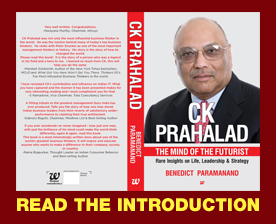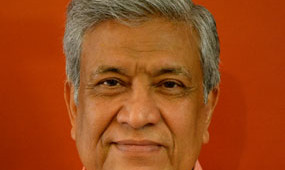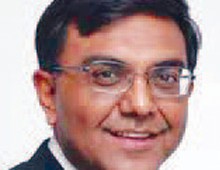 Laurence Cockcroft is a development economist and founder of Transparency International, a global civil society organization fighting corruption. He’s the author of Africa’s Way – A Journey from the Past. On a visit to India, he’s excited to see the emergence of the Aam Admi Party with the sole agenda of fighting corruption. Benedict Paramanand chats him up about his new book and how India can fight the menace of corruption differently
Laurence Cockcroft is a development economist and founder of Transparency International, a global civil society organization fighting corruption. He’s the author of Africa’s Way – A Journey from the Past. On a visit to India, he’s excited to see the emergence of the Aam Admi Party with the sole agenda of fighting corruption. Benedict Paramanand chats him up about his new book and how India can fight the menace of corruption differently
What are the key highlights of your book ‘Global Corruption: Money, Power and Ethics in the Modern World’ (published by VIVA)
‘Global Corruption’ covers the impact of corruption in many different parts of the world with a particular focus on the ways in which corruption perpetuates poverty , frequently undermines economic growth and can damage and destroy political stability. It draws on six major country ‘cases’ – Nigeria, Peru, Russia, Indonesia, Brazil and Mexico but adds material from many others including India. It identifies the main ‘drivers’ of corruption in these contexts (such as party finance, organised crime, continued corporate misconduct and the scale of the informal sector), describes the main bottlenecks to combating them but argues that international action as well as national action is necessary if they are to be rolled back. I suggest that recent international action by the G8 and G20 is hopeful but we have a long way to go.
How are the issues relevant to India?
Corruption in this country is complex and perhaps still lacks an analysis which shows how the different forms of corruption interact. However, the key ‘drivers’ I identify above are all prevalent in India. When I was writing the book and trying to learn more about the situation here I was increasingly convinced that your experience with the corrupt funding of parties is one of the clearest international examples of how political finance can trigger corruption much further down the social spectrum.
Secondly, there is no doubt that organised crime has a major role in Indian politics by buying into the campaigns of MPs for a return measured by corrupt favours. Thirdly, corporate corruption – characterised by crooked procurement deals such as G2 and Westland – is alive and well documented. Of course in many cases Indian companies are acting in partnership with international companies who regularly walk away from their ethical and legal commitments. Finally, as Prof. Arun Kumar has shown the existence of an enormous informal sector where ‘black money’ circulates freely constitutes a reservoir from which payment can be made to junior and not so junior officials off the radar of the regulators. So I think the underlying themes of the book are very relevant to India – some of whose frustrating anti corruption history I cover.
What has been the experience of global anti corruption campaigns in the last few decades?
The experience is really only about 20 years old, about the time that organisations like Transparency International, Global Witness and the Public Affairs Centre here in Bangalore were founded. I think these and others engaged in the same fight have done well in putting the corruption agenda on the world map – whether it’s the UN Convention against Corruption or the G20 agenda – there has been a sea change in recognition of the negative impact of corruption. This campaign has done well too in persuading many multinational companies – easily a majority of the top 500 – to adopt anti corruption compliance programmes, reflected down the scale for example in the 4000 companies – including many from India – that form the UN Global Compact.
However we have done less well at the country level where there is plenty of nominal progress but reality checks are not so convincing. And I would add in particular that the poor and marginalised, very often the most serious victims of corruption, have not been real beneficiaries of this effort. One current success story, however, is the adoption by the G8 of moves to eliminate the various ways in which ‘beneficial ownership’ of companies and financial assets can be disguised. I think this will lead to the ending of an abuse which has been critical in disguising the black holes in which corrupt funds are held.
What’s your view of India’s AAP?
The AAP is a great example of a political party which has morphed from a civil society action group. You might say the Green Party in Germany is one of the other very few examples. As many commentators have been indicating the business of governing is different to the business of protesting. However my current impression is that Kejirwal has an agenda which goes well beyond Delhi and may be more akin to Mao’s Cultural Revolution embodied in his command to ‘Bombard the headquarters’. Whether this is his intention or not, the fact of the matter is that governments have to change existing institutions and perhaps establish new ones in each case establishing that no individual is exempt. In this case it’s very relevant that the AAP is insisting that senior officials should not be exempt from any investigation by the Lokpal, even if the Constitution appears to allow for this.
What should AAP watch out for as a movement-cumpolitical party?
There are currently many examples of parties once in opposition which campaigned at least partly on anti corruption ticket and have later formed a government (e.g. Nigeria under Obasanjo, Venezuela under Chavez and Indonesia under Bambang Yudhoyono). In these cases it has proved extremely difficult to sustain that position as vested interests have reclaimed power, and of course the fruits of office have offered their own temptations. It will be essential for AAP to avoid compromise in its sound fund raising strategy and to exercise rigorous discipline in personal reward systems. The new Lokpal Act will help if its potential to investigate all complaints against public officials is sustained.
What are the best practices to make party funds more transparent?
There is no silver bullet which can solve the problem of party finance and corruption. The many models which exist around the world all have their faults and where concern about corruption is genuine there has to be a process of constant review. I would say the key issues in India are – 1) establish realistic (as opposed to unrealistic) spending limits both at the constituency and centre level; 2) maximise donations from a large number of people – as both Obama and the AAP have shown can be done; 3) provide state funding to match these small scale donations, but tied to a rigorous audit; 4) eliminate all funding by companies which have had a contract with the state over the last five years. Any or each of these rules can be circumvented but it is essential for the country to find ways to reform the current system.
After Enron there has been greater regulation of corporate corruption – is it working?
The Enron and WorldCom cases were a shock to the whole capitalist system and the post Enron legislation in the US, notably the Dodd Frank Act, has been an important step forward. However this legislation was conceived before the financial crisis of 2007-8 which revealed a further world of more or less corrupt practice in the US and European banking sectors. Enormous fines have been imposed – for example totalling $20 billion on Morgan Stanley in 2013. Further, even long established measures such as the US Foreign Corrupt Practices Act have failed to rein in some of America’s biggest companies – Wal- Mart has admitted paying bribes totalling about $24 million from 2002-8 through its Mexican affiliate. Nonetheless, most international companies will now think more than twice about paying a bribe to expand market share. Frankly, it is not clear whether the big investment banks have really changed the way they think about risk, money laundering and compliance.
I should add that the question of ‘mispricing’ – corporate manipulation of the prices at which exports and imports are recorded in order to channel funds to low tax ‘secrecy jurisdictions ’ – remains unresolved and we are a long way from seeing an end to these practices. Over the last ten years Global Financial Integrity in Washington has pioneered regular analyses of these flows, showing, for example, an annual outflow from India between 2002 and 2011 of $34 billion per year – and a cumulative external fund, held in these jurisdictions, of $340 billion. This represents a huge cost to the Indian economy, and one in which both domestic and international companies are closely involved. This is something which I discuss at the international level at length in the book.
What radical idea would bring down the level of global corruption? The ‘secrecy jurisdictions’ (often known as offshore centres) where perhaps a majority of corruptly gained funds – from organised crime, corporate mispricing, and corruption in procurement are held – are a huge incentive to these forms of corruption. Over the last forty years the knowledge that you can set up an account in London, Zurich, the Cayman Islands or Lichtenstein and count on its anonymity has spurred a wide variety of corrupt deals. This whole system is now being tightened up, but it is imperative that newer centres such as Dubai and Singapore do not take over the business on the same terms. But if the ‘secrecy’ element in all these jurisdictions were eliminated global corruption would face a real challenge.











Recent Comments